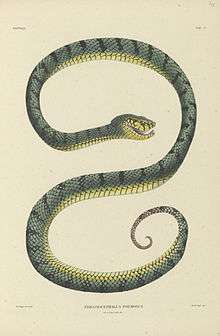Trimeresurus sumatranus
| Trimeresurus sumatranus | |
|---|---|
 | |
| Scientific classification | |
| Kingdom: | Animalia |
| Phylum: | Chordata |
| Class: | Reptilia |
| Order: | Squamata |
| Suborder: | Serpentes |
| Family: | Viperidae |
| Genus: | Trimeresurus |
| Species: | T. sumatranus |
| Binomial name | |
| Trimeresurus sumatranus Malhotra et al., 2011 | |
| Synonyms | |
| |
Trimeresurus sumatranus is a venomous pitviper species found in Thailand, Malaysia and Indonesia. Arboreal, its coloration is pale green with a red tail. Two subspecies are currently recognized, including the nominate subspecies described here.[7]
Description
Trimeresurus sumatranus is a large heavy-bodied pitviper, with a prehensile tail. Adults may attain 1.6 metres (5 feet 3 inches) SVL (snout-vent length), with fangs over 10 mm (⅜ inch) long.[8]
It is an arboreal species that is pale green in color with a red tail.[5] The dorsal scales are edged with black, which may form crossbands in more mature specimens. There is a white or yellow stripe on each side along the first row of dorsal scales. Ventrally it is greenish or yellowish, and the ventral scales may be thinly edged with black.[9]
Scalation includes 21 (23) rows of dorsal scales at midbody, 183-190/182-191 ventral scales in males/females, 57-66/55-64 subcaudal scales in males/females, and 8-10 supralabial scales.[4]
Habitat
In Borneo it inhabits lowland forests at elevations below 800 meters (2,600 feet).[8]
Behavior
It is nocturnal, climbing onto low branches to hunt its prey.[8]
Diet
The diet consists mainly of small mammals, birds,[5] and frogs.[8]
Geographic range
Found in southern Thailand, West and East Malaysia (Sabah and Sarawak on Borneo) and Indonesia (Bangka, Billiton, Borneo, Sumatra and the nearby islands of Simalur, Nias, and possibly the Mentawai Islands [Sipora]). The type locality given is "Sumatra."[2]
According to Gumprecht et al. (2004), the records regarding its occurrence in the Mentawai Islands are probably based on T. hageni.[4]
Venom
Because it is a large snake with large fangs, Trimeresurus sumatranus can inject large quantities of venom. Fatalities from its bite have been reported, and it should be considered extremely dangerous.[8]
Subspecies
| Subspecies[7] | Taxon author[7] | Common name[4] | Geographic range[4] |
|---|---|---|---|
| T. s. malcolmi | Loveridge, 1938 | Malcolm's pitviper | East Malaysia at 1,000-1,600 m elevation (3,280-5,250 feet). |
| T. s. sumatranus | (Raffles, 1822) | Sumatran pitviper | Thailand (Pattani Province and Betong in Yala Province), West Malaysia, East Malaysia (Borneo), Indonesia (Kalimantan, Sumatra, Simalur, Nias, the Mentawai Islands [Sipora], Bangka and Billiton). |
See also
- List of crotaline species and subspecies
- Trimeresurus by common name
- Trimeresurus by taxonomic synonyms
- Crotalinae by common name
- Crotalinae by taxonomic synonyms
- Snakebite
References
- ↑ http://www.iucnredlist.org/details/178274/0
- 1 2 McDiarmid RW, Campbell JA, Touré T. 1999. Snake Species of the World: A Taxonomic and Geographic Reference, Volume 1. Herpetologists' League. 511 pp. ISBN 1-893777-00-6 (series). ISBN 1-893777-01-4 (volume).
- ↑ The Reptile Database. www.reptile-database.org.
- 1 2 3 4 5 Gumprecht A, Tillack F, Orlov NL, Captain A, Ryabov S. 2004. Asian Pitvipers. Geitje Books. Berlin. 1st Edition. 368 pp. ISBN 3-937975-00-4.
- 1 2 3 Mehrtens JM. 1987. Living Snakes of the World in Color. New York: Sterling Publishers. 480 pp. ISBN 0-8069-6460-X.
- ↑ Brown JH. 1973. Toxicology and Pharmacology of Venoms from Poisonous Snakes. Springfield, Illinois: Charles C. Thomas. 184 pp. LCCCN 73-229. ISBN 0-398-02808-7.
- 1 2 3 "Trimeresurus sumatranus". Integrated Taxonomic Information System. Retrieved 26 July 2008.
- 1 2 3 4 5 Das, Indraneil. 2006. A Photographic Guide to Snakes and Other Reptiles of Borneo. Ralph Curtis Books. Sanibel Island, Florida. 144 pp. ISBN 0-88359-061-1. (Parias sumatranus, p. 55.)
- ↑ Boulenger, G.A. 1896. Catalogue of the Snakes in the British Museum (Natural History). Volume III., Containing the...Viperidæ.. Trustees of the British Museum (Natural History). (Taylor and Francis, Printers.) London. xiv + 727 pp. + Plates I.- XXV. (Lachesis sumatranus, pp. 557-558.)
Further reading
- Raffles, T.S. 1822. Second Part of the Descriptive Catalogue of a Zoological Collection made in [sic] the Island of Sumatra and its vicinity. Transactions of the Linnean Society of London 13 (2): 277-340. (Coluber sumatranus, p. 334.)
External links
- Trimeresurus sumatranus at the Reptarium.cz Reptile Database. Accessed 24 December 2012.
